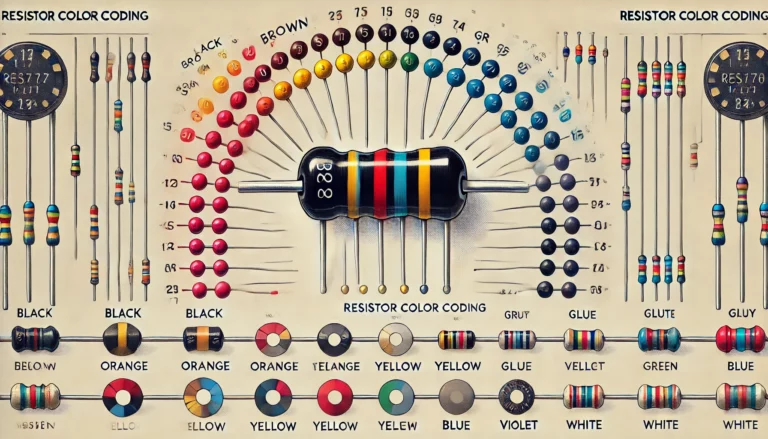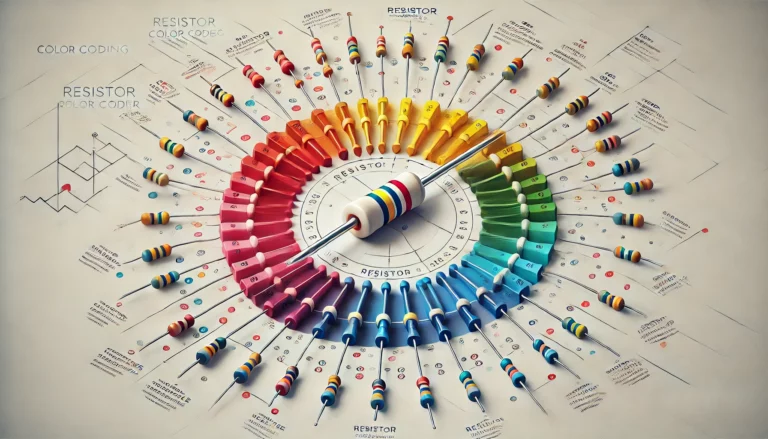What Do Resistor Color Bands Represent
Table Of Contents
Understanding Resistor Color Code and What Do Resistor Color Bands Represent
Key Takeaways
- Interpretation of resistor color bands and comprehension of resistor color coding
- Clarification of the resistor color coding system
- Varieties of resistor color coding systems
- Significance of banded resistors
- Unique instances of six-band resistor color coding
- Useful advice for deciphering resistor color codes
What Do Resistor Color Bands Represent | Understanding Resistor Color Codes
Understanding the meaning behind resistor color bands is essential for anyone working with electronics. The resistor color code serves as a universal language that communicates the resistance values and tolerances of resistors through a series of colored bands. Each color corresponds to a specific number, allowing users to decode the resistor’s specifications quickly. The resistor color codes are designed to be easy to interpret, but knowledge of the standard color sequences is crucial. By grasping what do resistor color bands represent, individuals can avoid errors in circuit design and ensure that components are correctly utilized. The RMA resistor color code and other resistance color codes streamline this process, making it accessible even for beginners in electronics.
- The first two bands indicate the first two significant digits of the resistor value.
- The third band represents the multiplier, determining the number of zeros to add.
- The fourth band, if present, indicates the tolerance level of the resistor, showing how much the resistance can vary.
- The color code uses a range from black (0) to brown (1) and red (2) through to gray (8) and white (9).
- Using a handy resistor color code chart can simplify the decoding process for beginners.
- Mistakes in reading resistor color bands can lead to improper circuit assembly, so verification is advisable.
- Familiarity with the color code can enhance efficiency when working with multiple resistors in a project.
What Do Resistor Color Bands Represent | Overview of Resistor Band Colors
Resistor color bands provide an essential coding system used to identify the resistance values of fixed resistors, including film resistors and carbon-composition resistors. Understanding what resistor color bands represent is crucial for anyone involved with electronics, as it enables accurate interpretation of resistor code. These codes help determine the resistance value, tolerance, and sometimes even the temperature coefficient of power resistors. For instance, a zero-ohm resistor, which functions like a wire, will also have a color code that indicates its nominal value.
The significance of resistor color bands extends beyond standard resistors to various applications, including pull down resistors and power resistors. Each color represents a specific numerical value, allowing for quick calculations and adjustments in circuit design. What do resistor color bands represent in practical terms? They indicate not only the resistance but also the type of resistor being used, helping engineers and hobbyists alike to select appropriate components for their projects. Understanding this coding effectively can simplify troubleshooting and enhance circuit functionality.
The Significance of Each Resistor Color
Each color in the resistor color code serves a crucial role in indicating specific values related to resistances and electrical resistance. The primary purpose of these colors is to provide clear marking codes for resistors and capacitors. Understanding what do resistor color bands represent allows technicians and engineers to identify the resistance value and tolerance of components quickly. The array of colors represents numerical values that correlate to resistances in ohms, providing a straightforward method for determining the properties of wire-wound resistors.
The significance of the color code extends beyond mere identification of resistance values. Various colors are also indicative of the temperature coefficient of resistance, which affects how resistors perform under different thermal conditions. Knowing the color codes enhances the reliability of both resistor and capacitor selections in electronic circuits. Each color has a specific meaning, facilitating effective communication of component specifications among professionals in the field. This systematic approach is essential for ensuring optimal performance and reliability in electrical designs.
The Resistor Color Code Explained
Understanding the resistor color code is essential for anyone working with electronic components. What do resistor color bands represent? These color bands indicate the resistance value, tolerance, and sometimes the temperature coefficient of a resistor, enabling accurate color-coding on a circuit board. The electronic color code employs a specific sequence, commonly known as the EIA color code, to designate values using colors, thereby simplifying identification. For those who are color-blind, the RMA color coded system provides additional clarity by offering alternative methods to determine resistor values. In more advanced resistors, such as the 25-pair color code or 6-band configurations, the functionality can extend beyond basic polarity, revealing critical characteristics in metal film resistors. Understanding these codes is vital for effective design and troubleshooting in electronic circuits.
The Standard Resistor Color Code
Resistor color bands serve a vital purpose in determining the value and tolerance of resistors. Each color on a band resistor color indicates a specific number or multiplier. For instance, violet represents the number 7, while gold and silver indicate tolerance levels of ±5% and ±10% respectively. Understanding what do resistor color bands represent is crucial for anyone working with circuits involving volts, capacitors, and inductors to ensure proper functionality and accuracy.
The standard resistor color code typically involves four or five bands, though some advanced circuits may utilize a 6-band resistor color configuration. These additional bands help specify even finer tolerances or temperature coefficients. Emphasizing the significance of resistor color bands can prevent errors in circuit design and implementation. What do resistor color bands represent goes beyond just values; it encompasses the overall reliability and performance of electrical components in various applications.
| Color | Number | Tolerance |
|---|---|---|
| Black | 0 | N/A |
| Brown | 1 | ±1% |
| Red | 2 | ±2% |
| Orange | 3 | N/A |
| Yellow | 4 | N/A |
| Green | 5 | ±0.5% |
| Blue | 6 | ±0.25% |
| Violet | 7 | ±0.1% |
| Gray | 8 | ±0.05% |
| White | 9 | N/A |
| Gold | N/A | ±5% |
| Silver | N/A | ±10% |
How to Read Resistor Bands
Reading resistor bands requires an understanding of resistor color coding principles. Each band on a resistor signifies a specific value or tolerance, making it essential to interpret the color code accurately. What do resistor color bands represent? The first two bands indicate the significant digits of the resistor value, while the third band provides the multiplier. The final band typically reveals the tolerance level. By examining the color of each band, you can determine the resistor’s value and ensure it meets your project’s requirements.
The application of a flexible resistor color system enhances the ease of identifying resistor values. For example, a band resistor example may show bands of red, green, and orange, representing 25,000 ohms. Understanding resistor color should focus on recognizing the same resistor color across different resistors because it often indicates similar values. Using helpful resistor color charts can simplify this process, turning the task of deciphering color-coded resistors into a straightforward operation.
Types of Resistor Color Codes
Resistor color codes play a vital role in identifying the resistance value and tolerance of electronic components. What Do Resistor Color Bands Represent can vary among different types of resistors, including the four-band resistor and the three-band resistor. The standard four-band resistor typically uses a color code that indicates the first two digits of the resistance value, followed by a multiplier and tolerance. In contrast, the five-band resistor, such as the 5-band resistors used in precision applications, incorporates an additional band for greater accuracy. For those dealing with specialized components, six-band resistors offer even more detailed information, including temperature coefficient. Antique resistor color variations might differ from modern standards, emphasizing the importance of understanding the evolution of rma resistor color codes in various contexts.
Common Resistor Color Combinations
Resistor color bands play a crucial role in identifying resistor values across various resistor types. For instance, four-band resistors typically use the first two bands for significant digits, the third for a multiplier, and the fourth for tolerance. Different combinations can produce a wide array of resistor values, making them versatile for both standard applications and specialized circuits. New resistors may also adopt similar color coding methods, ensuring that the essence of “What Do Resistor Color Bands Represent” remains intact in modern designs.
A popular resistor kit often showcases common color combinations used in 3-band and 6-band resistors. The 3-band variant is simpler, generally representing lower precision, while the 6-band option provides additional accuracy through more detailed readings. As the resistor varies in complexity and application, awareness of these combinations is essential for those working with electronic components. Identifying a top resistor based on color band decoding can significantly assist in achieving desired resistor values in a circuit.
Exploring 5Band Resistors
Five-band resistors are known for their precision and ability to represent a wider range of resistance values than the more commonly used three-band resistors. What Do Resistor Color Bands Represent in this context becomes crucial as each color band corresponds to a specific digit or multiplier. Resistor manufacturers utilize five-band designs for specialized resistors that require stricter tolerances. These resistors enable more accurate adjustments in circuits where minor resistor changes can significantly impact functionality. Small resistors, such as surface mount devices (SMD), also benefit from this color-coding system, providing clarity in identifying their values.
The added band in five-band resistors typically denotes a tolerance percentage or a temperature coefficient, allowing for better performance in demanding applications. Understanding the implications of what resistor derating affects can further enhance the selection of the appropriate components. Basic resistor values are easier to discern with five bands, catering to both general-purpose and high-precision applications. This versatility makes five-band resistors essential in modern circuitry, ensuring reliability and efficiency across various electronic devices.
The Importance of Band Resistors
Understanding what do resistor color bands represent is crucial in modern electronics. Old style resistors often relied on simple numerical markings, but the use of color bands has evolved resistor technology significantly. Colored bands provide a quick and effective way to identify the resistance value, tolerance, and temperature coefficient of an ohm resistor. For example, a 200-ohm resistor can be easily recognized thanks to its specific color code, which is reflected on the resistor package. This resistor illustration change enhances accuracy and reduces the likelihood of misinterpretation in circuit design. Selecting the right power resistor based on these color-coded indicators ensures optimal performance in electronics.
The Role of Resistor Band Colors
Resistor band colors serve as an essential visual guide for understanding electrical components. What do resistor color bands represent? They indicate the resistance value, tolerance, and sometimes temperature coefficient of resistors. Different band colors correspond to specific numerical values according to a standardized code. The extra color band found in a 5-band color system allows for greater precision, enabling the identification of tight tolerance resistors and high precision resistors, which are crucial in various applications.
The significance of these colors extends to the classification of resistors. For instance, carbon-composition resistors often utilize simple band color codes, whereas more sophisticated designs may require multi-purpose resistor code systems. Being able to read resistors accurately is vital for ensuring reliable resistor performance in circuits. High precision resistors benefit from this detailed color coding, which supports engineers and technicians in selecting the right components for their specific needs. Understanding what do resistor color bands represent ultimately enhances the functionality and reliability of electronic devices.
Applications of Colour Coded Resistors
Coloured band resistors serve a vital role in a variety of electronic applications. High-precision resistors are often essential in circuits requiring accurate resistance values. For instance, a 200-ohm resistor may be used in sensitive audio equipment where precision is crucial. Understanding what do resistor color bands represent can help engineers and hobbyists alike select the correct components. High-voltage resistors are another example where the color coding is essential for ensuring the right specifications are met, particularly in high-stakes environments.
Tolerance bands on resistors indicate how much resistance can vary from the stated value. This is significant for both cylindrical composition resistors and high voltage resistors where even minor discrepancies could affect circuit performance. What do resistor color bands represent extends beyond mere identification; it influences the design and effectiveness of electronic systems. Consulting resistor data sheets further clarifies these specifications, aiding in maintaining the integrity of the circuitry involved.
Special Cases: 6Band Resistor Color Codes
Understanding what resistor color bands represent is crucial for distinguishing between various resistor types, especially when it comes to six-band resistors. These resistors often feature an additional band that provides extra precision, particularly useful in applications requiring ohmic or high voltage resistors. The first five bands represent the resistance value, while the sixth band color indicates tolerance or temperature coefficient, adding depth to the information conveyed by the bands. Such bands can come in different colors, with common color choices that help identify low resistance values or specific characteristics like those seen in RMA resistors. For electronics enthusiasts, recognizing the significance of each of the six bands is key to accurately interpreting the resistor specifications and ensuring optimal performance in circuits.
Understanding 6Band Resistor Functionality
Six-band resistors expand on the traditional color band system by introducing additional bands that enhance their functionality. With this configuration, the first three bands represent significant digits, the fourth band denotes the decimal multiplier, the fifth band indicates tolerance, and the sixth band may represent temperature coefficient. Understanding what do resistor color bands represent is crucial for accurately determining resistance values. The inclusion of silver or gray bands can provide insights into how closely a resistor might meet its specified actual resistance value.
Using an automatic resistor calculator can simplify the process of decoding these colors. Online resistor calculators can also assist in confirming resistance values by allowing users to input the color codes. Each band serves a purpose, and neglecting one could lead to miscalculations. The fourth color band is particularly important as it specifies tolerance, helping users gauge the reliability of the component. Knowing these intricacies ensures that you select resistors with the same resistance in applications requiring precise specifications.
Comparing 5Band and 6Band Resistors
5-band resistors differ from 6-band resistors in their configuration and the additional information they provide. What do resistor color bands represent? A 5-band resistor typically consists of five distinct colors that indicate the preferred resistance value, while a 6-band resistor includes a sixth metallic band that signifies temperature coefficient or a second tolerance value. The color boundaries in these bands help in accurately determining resistance, while colors also indicate tolerance in different ways.
Understanding the differences allows for better applications in specialized circuits. The ring color in the sixth band is particularly useful for fine-tuning and ensuring stability in sensitive applications, providing a level of detail that 5-band resistors may lack. Both types utilize colors to convey important electrical properties, but the extra band in the 6-band resistor allows for more precise adjustments. Knowing how to interpret these color codes is essential for effective circuit design.
- 5-band resistors provide a preferred resistance value with greater accuracy than standard 4-band resistors.
- 6-band resistors add an additional band for temperature coefficient, enhancing thermal stability.
- The extra sixth band allows for more precise tolerance specifications in critical applications.
- Color coding in both 5-band and 6-band resistors follows the same standard chart, ensuring consistent interpretation.
- 5-band resistors are commonly used in general-purpose applications, while 6-band resistors are preferred for high-precision circuits.
- Understanding the differences in configuration helps engineers select the appropriate resistor for their design needs.
- Both resistor types contribute to the reliability and performance of electronic components in various devices.
Practical Tips for Reading Resistor Color Codes
Understanding what do resistor color bands represent is essential for anyone working with electronic components. Each band has a specific meaning, dictated by standard color codes that indicate resistance values and tolerances. Recognizing the significance of corresponding colors and the correct color order helps in interpreting the actual bands on a resistor. Different band types, such as 4-band, 5-band, and 6-band resistors, may include extra bands that offer additional information about resistance or temperature coefficients. Observing the body color and the particular colors in the sequence provides insight into how to decode the color code accurately. Becoming proficient at reading resistor bands ultimately leads to better circuit design and troubleshooting.
Tools for Decoding Resistor Codes
Decoding resistor color codes requires an understanding of the common color-coding system used in electronics. What Do Resistor Color Bands Represent? Each band on a resistor corresponds to a specific value, with the standard color code indicating significant digits, tolerance, and temperature coefficient. The third color band typically represents a multiplier, while colors like gold specify tolerance. Mastery of these colour codes facilitates accurate readings of resistance values, allowing for proper integration into various circuits.
Various tools can assist in interpreting resistor values efficiently. Color code calculators and charts provide immediate reference for quickly determining value bands based on the colored rings present. The RMA color coding chart outlines industry standards, helping users familiarize themselves with the color spectrum for resistors. Understanding how bands varies in design and function enhances one’s ability to read resistors effectively, ensuring optimal circuit performance.
| Tool Type | Tool Name | Description | Usage |
|---|---|---|---|
| Calculator | Resistor Color Code Calculator | An online or app-based tool that allows users to input color bands and receive the resistor value instantly. | Quick reference for software engineering and electronics design. |
| Chart | Resistor Color Code Chart | A printed reference chart displaying the color bands and their corresponding values for quick lookup. | Useful for technicians and hobbyists working in labs or workshops. |
| Mobile App | Resistor Code Reader | A mobile application that uses the camera to scan resistor color bands and output the resistance value. | Convenient for field work and DIY projects. |
| Reference Book | Electronics Handbook | A comprehensive guide that includes resistor color codes, calculations, and other electronics fundamentals. | Valuable resource for students and professionals learning electronics. |
Common Mistakes When Reading Resistor Bands
Misinterpretation often occurs with the fourth color on resistors, which indicates tolerance levels. Many assume that all resistors follow a consistent pattern, overlooking variations such as the presence of a white tolerance ring or non-standardized jacket colors. Understanding what resistor color bands represent is crucial, especially with 4-band types where red bands and a black band can easily confuse those unfamiliar with the nuances.
Errors may also arise from grouping bands incorrectly, particularly with resistors featuring additional bands. It’s essential to remember that each color has specific meanings and that brown colors signify significant digits. Failing to recognize an own color code can lead to incorrect readings. Taking the time to familiarize oneself with these details can prevent frustration and ensure accuracy in electronic projects.
Conclusion
Understanding What Do Resistor Color Bands Represent is crucial for anyone working with electronics. The color coding system utilizes a specific colour sequence to indicate the resistance value, tolerance, and other characteristics of a resistor. Each color corresponds to a number, with the gold band often representing a tolerance of 5%. For more precise applications, the temperature coefficient band may also be included, providing insight into how the resistor will perform under varying thermal conditions. By familiarizing yourself with these elements, you can accurately interpret resistor specifications and enhance your project outcomes.
FAQS
How can I identify the value of 5-band resistors using resistor colors and the resistor colour code?
To identify the value of 5-band resistors, you can use the resistor colour code which assigns different colours to specific numbers. The first three bands represent significant digits, the fourth band indicates the multiplier, and the fifth band is used to determine the percentage tolerance of the resistor. Understanding the colour bands and their corresponding values is essential for accurately reading the resistance colour codes of many resistors.
How does the color code for resistors differ when dealing with 6-band resistors compared to 3-band resistors, especially in relation to black resistor bands?
The color code for resistors varies significantly between 3-band resistors and 6-band resistors. For 6-band resistors, the resistor colour coding includes additional bands that provide more precision in measurement compared to the standard 3-band configuration. In 6-band resistors, the first two bands represent significant digits, the third band is a multiplier, the fourth is a tolerance band, and the last two bands can denote temperature coefficient values or have specific functions for high precision. Black resistor bands indicate a value of zero, which means that it will not contribute to the significant digits. This more complex colour coding allows for greater accuracy in electronic applications, whereas the simpler 3-band resistors typically suffice for general purpose usage with fewer requirements for precision.
What do 6-band resistor color codes indicate compared to the standard resistors colour coded with fewer bands?
The 6-band resistor color codes provide more precise readings for the resistors, as they include an additional band that often represents the tolerance level or a multiplier. Unlike standard resistors colour coded with fewer bands, where the value is deduced from the first three or four bands, the sixth band can indicate the reliability of the resistor’s values. This is especially crucial for high precision devices such as five-band precision resistors or specialized applications involving ohmic/high voltage resistors. It is also important to note that while the resistor colour codes may seem complicated, they follow the electronic colour code which assists in correctly identifying various resistor types, including SMD resistors and zero-ohm resistors.
How do the color code resistors help color blind individuals understand band type resistor values?
The color code resistors can be challenging for color blind individuals, as the band colours indicate values such as 2, 22, and 200-ohm resistor ratings. However, understanding the different band types—like the four-band and six-band color codes—can aid in interpreting resistor-like body values. Using silver bands and identifying the fourth tolerance band can further assist in determining colour code values, even in the presence of non-standardised jacket colors.
What does the term “band type resistor” refer to when comparing general purpose resistors with few bands versus those with several bands, such as the 22 and 200-ohm resistor examples?
The term “band type resistor” pertains to the different configurations of resistors, such as general purpose resistors which can have few bands, like 22 and 200-ohm resistors, or several bands that provide more precision. Resistors with colors like gold often represent tolerance in grouped bands, allowing for better understanding of resistor values in electronics.
What is the importance of the colors gold and other colors when distinguishing values in different band type resistors, like the 22 and 200-ohm resistor?
The colors gold and other colors are crucial in the resistor color code as they help identify the resistance values of different band type resistors, such as the 22 and 200-ohm resistor. Specifically, gold indicates a tolerance level, while the colors used in the bands determine the actual resistance value, which in the case of a 200-ohm resistor would be different from that of a 22-ohm resistor.
How do I determine the resistance values of different band type resistors, like a 22-ohm resistor and a 200-ohm resistor?
To determine the resistance values of different band type resistors, you need to interpret the color bands. For example, a 22-ohm resistor would typically have specific colors that represent the numbers 2 and 2, while a 200-ohm resistor will have its own distinct color arrangement reflecting the numbers 2 and 0. The bands indicate the significant digits and multiplier which allow the calculation of the resistance value for both the 22-ohm resistor and the 200-ohm resistor.
What are the differences in resistance values between a 22-ohm resistor and a 200-ohm resistor when examining their band type resistors?
The resistance value of a 22-ohm resistor is significantly lower than that of a 200-ohm resistor. When looking at band type resistors, the color bands indicate the respective values where the 22-ohm resistor typically has fewer color bands than the 200-ohm resistor, which may have additional bands to indicate its higher precision.
How do the resistance values of a 22-ohm resistor and a 200-ohm resistor compare when looking at their corresponding band type resistors?
When comparing a 22-ohm resistor to a 200-ohm resistor, the primary difference in their band type resistors is the value indicated by the number of bands and their colors. A 22-ohm resistor typically uses fewer colors while a 200-ohm resistor may employ more distinct bands to clearly differentiate them, often showing the values more accurately in circuits where precision is essential.
How do I know the resistance value of a 22-ohm resistor compared to a 200-ohm resistor when using band type resistors?
To identify the resistance values of band type resistors like a 22-ohm resistor and a 200-ohm resistor, you can examine the color bands according to the resistor color code. For example, a 22-ohm resistor may have color bands representing the numbers 2 and 2, while a 200-ohm resistor will have bands indicating the numbers 2 and 0.







